Before you even think about breaking ground for a pool fence in Phoenix, the first thing on your list should be getting a handle on the city’s safety regulations. Seriously. Getting this part right from the start is the difference between a smooth project and one that’s bogged down in costly delays and failed inspections.
Phoenix Pool Fence Laws You Need to Know
Before a single post hole is dug, your plan has to line up perfectly with Phoenix and Arizona state safety codes. These aren't just friendly suggestions; they're mandatory rules designed to prevent tragedies. If you miss the mark, you’ll be redoing work and waiting even longer to enjoy your pool.
Knowing these rules from the get-go is key. The City of Phoenix has laid out some very clear, non-negotiable standards for every single piece of a pool barrier, from how tall it is to how the gate latches.
Core Height and Construction Requirements
The absolute baseline for any pool fence in Phoenix is its height. The law is crystal clear: all pools must be surrounded by a fence or wall that’s at least 5 feet high and is considered "non-climbable."
This 5-foot measurement is taken from the ground on the side of the fence facing away from the pool. So, what exactly does "non-climbable" mean in the real world?
- No easy handholds or footholds: The design can't have horizontal bars or decorative cutouts that a child could use as a ladder.
- Tight vertical spacing: If you're using a fence with vertical slats (like wrought iron or aluminum), the gaps between them can't be wider than 4 inches.
- Small mesh openings: For chain link or similar mesh-style fences, the openings in the mesh must not be larger than 1.75 inches across.
I see this all the time: homeowners install a perfect fence but then place climbable things like planters, benches, or pool equipment right next to it. The city requires a clear zone around the barrier to make sure it stays non-climbable.
The Critical Role of Pool Gates
A fence is only as good as its gate, and trust me, Phoenix inspectors look at gates with a magnifying glass. This is where most safety breaches happen, so just having a gate isn’t enough—it has to work in a very specific way.
The two most important features are the self-closing and self-latching mechanisms. This means every single time the gate opens, it has to swing completely shut and latch securely on its own, without anyone needing to push or pull it. This is a lifesaver for those moments when someone forgets to close the gate behind them. You can learn more about the importance of high-quality pool gates and fences in keeping your family safe.
On top of that, the gate's hardware has to meet precise specs:
- Latch Height: The release mechanism for the latch has to be on the pool side of the gate, at least 54 inches up from the bottom.
- Outward Swing: All pool gates are required to open outward, away from the pool. This is a clever detail that prevents a child from simply pushing their way into the pool area.
Following these rules isn't just about passing an inspection; it's about creating a truly secure backyard. A proper pool fence installation in Phoenix puts these safety standards first, giving you the peace of mind you deserve.
Planning Your Project and Securing Permits
A successful pool fence installation in Phoenix starts long before the first post goes in the ground. Honestly, the prep work is where you set your project up for success or failure. Getting the planning and permits right from the jump saves you from massive headaches, delays, and surprise costs later on.
The very first thing you need is an accurate site plan. I'm not talking about a quick sketch on a napkin, but a real, detailed map of your pool area. This becomes the blueprint for your fence and the key document the city needs for your permit.
Accurately Measuring Your Pool Area
Grab a long measuring tape and get precise measurements of the space you want to enclose. You’ll need the total linear footage, but you also have to note exactly where everything is located. The small details are what make a fence functional and compliant.
As you measure, make sure to mark down:
- Pool Decking: Where does your concrete, paver, or cool deck end?
- Landscaping: Pinpoint the location of trees, big shrubs, or any raised planters.
- Access Points: Decide where you want your gates for the most convenient flow.
- Utilities: Locate any visible pool equipment, electrical boxes, or water spigots.
With these details, you can draw a clear site plan showing the pool, the fence line, your gates, and the distance from the fence to the water's edge. This isn't just busywork; it's a critical part of your permit application.
Preparing for Your City of Phoenix Permit
Here's the deal: you can't just build a pool fence in Phoenix without permission. It's a mandatory step. The city's Planning & Development Department needs to review and approve your plans to make sure everything meets safety codes. Trying to skip this will earn you fines and an order to tear down your brand-new, unapproved fence.
Your permit application will need that detailed site plan we talked about, along with specifics on the materials and hardware you're using. A clear, accurate submission makes the approval process go so much faster.
A common mistake I see is homeowners assuming their contractor handles everything. While many pros do manage the permitting, you should always confirm this upfront. At the end of the day, you are the property owner, and you're the one responsible for making sure everything is compliant.
The Most Important Phone Call You Will Make
Before anyone even thinks about digging, there's one call you absolutely have to make: call 811. This service, known as Arizona 811 (what we used to call Blue Stake), gets local utility companies to come out and mark their underground lines.
Trust me, hitting a buried gas, water, or electrical line is a nightmare. It’s dangerous, expensive, and brings your project to a dead stop. A few days after you call, techs will show up and use paint or flags to mark the lines. It’s a simple step that protects you, your property, and your installers.
Nailing these planning steps ensures your pool fence installation in Phoenix starts on the right foot, paving the way for a smooth project from start to finish.
Choosing Fence Materials for the Arizona Climate
The relentless Phoenix sun is notoriously tough on outdoor materials. Between the powerful UV rays and the dry heat, your choice of pool fence material is about more than just looks—it's about longevity, safety, and how much time you want to spend on upkeep.
Let's break down the most popular options and see how they really hold up in the Valley. We're not just talking about what looks good on day one, but what will still be standing strong after years of desert exposure.
Removable Mesh Fencing
Mesh pool fencing is a huge favorite in Phoenix, and for good reason. It’s engineered specifically for safety and durability in sunny climates. The interwoven mesh is treated with UV inhibitors, which is critical here—it prevents the material from getting brittle or fading under our constant sun. That’s a massive advantage over other materials that can crack or warp.
The transparency is another key benefit. You get an unobstructed view of the pool from your house or patio, making it easy to keep an eye on things. That feature, combined with its non-climbable surface, makes it a top pick for families with young children.
- UV Resistance: High-quality mesh is built to resist sun damage, holding onto its strength and color for years.
- Upkeep: It's about as low-maintenance as it gets. A simple rinse with a hose is usually all you need to clear off the dust.
- Flexibility: You can take down sections for parties or events, giving you a level of versatility other fences just can’t offer.
Wrought Iron and Steel Fencing
For a more permanent and stately look, many Phoenix homeowners turn to wrought iron or steel. These materials bring a classic elegance and undeniable strength to a property. However, their performance in the desert climate depends entirely on one thing: the quality of the protective coating.
A powder-coated finish is non-negotiable. This process bakes a durable, protective layer onto the metal, shielding it from moisture and the intense sun that causes standard paint to chip and peel away. Without a solid powder coat, iron is susceptible to rust, especially when the monsoon season humidity spikes. If you're considering a robust and permanent barrier, you can find more details on durable steel fencing options in Scottsdale that are built for this climate.
A critical factor for iron fencing in Phoenix is heat absorption. A dark-colored iron fence can become extremely hot to the touch during the summer months—an important safety consideration, especially with curious kids around.
Aluminum Fencing
Aluminum gives you a look similar to wrought iron but with a huge advantage in Arizona: it’s naturally rust-proof. This makes it an excellent, low-maintenance choice for any poolside. Just like iron, it needs a high-quality powder coating to protect its appearance and prevent oxidation or chalking from UV exposure.
Because aluminum is lighter than steel, installation is often a bit simpler. It really strikes a great balance between durability, classic style, and minimal upkeep, making it a very practical long-term investment for a permanent pool fence installation in Phoenix.
Glass Panel Fencing
If you’re after a modern, high-end look, nothing beats tempered glass fencing. It provides a completely transparent barrier, offering maximum safety without interrupting the views of your beautiful pool and landscaping. The thick, tempered glass panels are incredibly strong and handle the temperature swings of the desert without issue.
The main drawback? Cleaning. Phoenix is a dusty place, and glass will show every bit of dirt, dust, and hard water spots. You'll need to commit to regular cleaning with a squeegee and the right glass cleaner to maintain that pristine, invisible look.
Phoenix Pool Fence Material Comparison
To help you weigh the pros and cons, here’s a quick comparison of how these materials stack up for a home in the Phoenix area.
| Material Type | Durability in Phoenix Climate | Typical Maintenance | Aesthetic Style |
|---|---|---|---|
| Removable Mesh | Excellent UV resistance; designed for sun | Low; occasional rinsing | Modern, transparent, safe |
| Wrought Iron/Steel | High, but depends on quality of powder coat | Medium; inspect for chips, touch-up paint | Classic, traditional, elegant |
| Aluminum | Excellent; rust-proof and durable | Low; occasional cleaning | Modern, versatile, clean lines |
| Tempered Glass | Excellent; unaffected by sun or heat | High; frequent cleaning required | Luxurious, modern, unobstructed |
Ultimately, choosing the right material means balancing the look you want with the practical realities of maintenance and long-term performance in our unique desert environment.
What to Expect During Professional Installation
So, you’ve picked out the perfect fence material and your permits are approved. Now for the exciting part: installation day. Knowing what the pros do during a pool fence installation in Phoenix helps you understand the process and spot the difference between a quick job and a high-quality, secure one. It’s a precise operation, moving from careful planning to final safety checks.
The whole thing kicks off with a meticulous layout of the fence line. A good installer doesn’t just start drilling holes. They’ll use chalk lines or paint to mark the exact path of the fence, making sure every line is straight and every curve is smooth, perfectly following your pool deck’s shape. This first step is critical—even tiny measurement mistakes here can cause big headaches later.
Precision Layout and Core Drilling
Once the fence line is marked out, the crew will pinpoint the exact spot for every single fence post. The spacing is carefully calculated to keep mesh fences tight or to give rigid fences like aluminum and iron the structural support they need. Nothing gets drilled until every post location is marked with precision.
Next comes core drilling. This is a specialized technique used to cut clean, perfectly sized holes into hard surfaces like concrete, travertine, or pavers. Instead of using a jackhammer that can crack your beautiful decking, core drilling uses a diamond-tipped bit to cut a smooth, perfect circle. This is essential for a secure fit and a professional finish.
- For Concrete Decks: The core drill cleanly pulls out a plug of concrete, leaving the perfect hole for the post sleeve.
- For Paver Decks: Installers will drill carefully through the paver and into the base below it, creating a solid foundation for the post.
This infographic gives you a quick visual of the different materials an installer might be working with. Each one needs a slightly different touch when it comes to anchoring.
From flexible mesh to rigid glass, the material choice really dictates the specific techniques the installation team will use.
Securing Posts and Getting the Tension Just Right
With the holes drilled and cleaned of debris, the installers set the post sleeves. These are small inserts that hold the actual fence posts. They're typically secured with a high-strength, fast-setting cement or epoxy to make sure they never shift or loosen. This anchoring is what gives your fence its strength.
For removable mesh fences, getting the tension right is both an art and a science. The installers put the posts into the sleeves, attach the mesh panels, and then systematically tighten the tension between each section. They pull it taut to create a firm barrier that can't be easily climbed. A properly installed mesh fence will have very little sag or slack.
A wavy or loose mesh fence is a classic sign of an amateur job. Professional installers know how to balance the tension across the entire fence line so it stands straight and rigid for maximum safety.
For solid fences like aluminum or iron, the posts are set first, and then the panels are securely fastened between them. Here, the focus is on making sure all the connections are rock-solid and the panels are perfectly level, even if your yard has a slight slope.
Gate Installation and Latch Adjustment
The final—and arguably most important—step is installing the gate. This is the part of the fence that gets used the most, and it’s what city inspectors look at first. A professional pool fence installation in Phoenix guarantees the gate meets all local safety codes, period.
Installers will hang the gate so it swings outward, away from the pool, just as the law requires. They’ll then install and calibrate the self-closing hinges, tweaking the tension until the gate closes smoothly and reliably every single time. The final piece is the self-latching mechanism, which has to be at least 54 inches from the ground to stay out of a toddler's reach. The team will test the gate over and over to make sure it closes and latches securely from any position. This fine-tuning is what separates a professional job from the rest and is absolutely crucial for a safe pool area.
To ensure all of your property’s access points are just as secure, you can explore a range of expert services for gates and fences in Scottsdale and Phoenix.
Budgeting for Your Phoenix Pool Fence
Setting a realistic budget is one of the first and most important steps in any pool fence installation Phoenix project. The final cost isn't just one single number; it's a combination of several key factors, and understanding them helps you plan effectively and see the value behind each choice you make.
The biggest piece of the puzzle is almost always the material you select. As we've covered, your options range from flexible mesh to sturdy aluminum and even elegant glass, each carrying a different price tag per linear foot. This is where your design vision meets your wallet.
The other major driver is simply the size of the fence. A straightforward barrier around a small spool will naturally require less material and labor than a complex layout wrapping around a large, freeform pool and the entire patio. Getting an accurate measurement of the perimeter is the best way to start building a clear financial picture.
Key Factors That Shape Your Budget
Beyond the basics of material and size, a few other details will definitely influence the total investment. For instance, the complexity of your yard can play a big part. A flat, level concrete deck is pretty straightforward, but a yard with slopes, different levels, or lots of landscaping to work around will add to the installation time.
The number of gates you need also adds to the bottom line. Each gate is more than just an opening; it’s a mechanical system with self-closing hinges and a self-latching mechanism, which means more cost for both materials and the specialized labor to install it correctly.
Here are the main elements that will make up your final quote:
- Fence Material: Your choice—be it mesh, aluminum, iron, or glass—will be the biggest variable in the cost.
- Total Length: The perimeter of the fenced-in area directly scales the amount of material and labor required.
- Number of Gates: Each gate adds a specific cost for the hardware and the time it takes to get it perfectly aligned and functioning.
- Yard Complexity: Slopes, different surfaces (like pavers versus concrete), and existing obstacles can increase labor hours.
- Permit Fees: Don't forget that the City of Phoenix requires permits, which come with an administrative fee.
It’s helpful to think of your pool fence as a permanent home improvement. The choices you make on materials and professional installation contribute directly to your property’s safety and long-term value, not just its looks.
Realistic Installation Ranges in Phoenix
To put together a practical budget, it helps to know the typical investment ranges for different materials here in the Phoenix area. A pool fence project can vary quite a bit, with most falling somewhere between $1,500 and $15,000, though high-end projects can go even higher.
For example, mesh pool fencing generally runs between $15 and $30 per linear foot. Aluminum is often in a similar $20 to $30 per linear foot range. If you're going for that high-end, modern look, tempered glass is the premium choice, typically ranging from $200 to $600 per linear foot. You can dig into more specifics by checking out this guide on Phoenix pool fence costs from Pool Guard USA.
These numbers give you a solid baseline for your financial planning. By combining these per-foot estimates with your own measurements and project details, you can develop a budget that's accurate and realistic, making sure you’re fully prepared for the investment needed to secure your pool and protect your family.
Maintaining Your Fence for Lasting Safety
Your new pool fence is a critical layer of protection, but its job isn't over once it's installed. Here in Phoenix, the harsh sun and seasonal dust storms mean a little routine care goes a long way. Keeping your fence in top shape ensures it functions perfectly for years to come.
Think of it like a car—a few quick checks can prevent major issues down the road. Luckily, maintaining your pool fence installation in Phoenix is straightforward and takes just a few minutes each month.
Routine Inspection Checklist
A simple visual inspection is your best friend when it comes to fence upkeep. Once a month, just take a quick walk around the fence line and keep an eye out for anything that seems off.
Here are the key spots to focus on:
- Gate Latches and Hinges: Open and close every gate a few times. Does it swing shut smoothly? Most importantly, does it latch securely on its own every single time? This is non-negotiable for safety.
- Fence Tension: For mesh fences, the material should feel taut and firm, with no sagging. If you have a rigid fence like aluminum or iron, give the panels a gentle shake to make sure they're secure and not rattling.
- Post Stability: Gently push on the fence posts. They should be absolutely rock-solid in the ground with zero wobbling or looseness.
Catching a loose hinge or a sticky latch early is a simple fix. Letting it go can compromise the entire safety system, which is why these quick, regular checks are so important.
Cleaning for the Phoenix Climate
In Arizona, dust and sun are the two biggest enemies of any outdoor material. A proper cleaning routine not only keeps your fence looking sharp but also extends its lifespan.
For most materials like mesh, aluminum, and powder-coated iron, a simple rinse with a garden hose is all you need to wash away the dust. If you're dealing with tougher grime, a soft cloth with a bit of mild soap and water will do the trick. Just be sure to never use harsh chemicals or abrasive scrubbers, as they can easily damage the protective coatings.
Spotting the early signs of wear—like tiny chips in a powder coat or slight fraying on mesh—allows you to do quick touch-ups before the damage spreads. These simple maintenance habits are just as crucial as understanding the 5 key features to look for in high-quality security fencing from the very beginning.
Have Questions About Phoenix Pool Fences? We've Got Answers.
When you start planning for a pool fence in Phoenix, a lot of questions come up. It's totally normal. Getting the right answers is the key to feeling good about your investment and, more importantly, your family's safety. We hear the same questions from homeowners all the time, so let's walk through some of the most common ones.
One of the first things people ask is about potential damage. "What happens if a part of my mesh fence gets torn?" It’s a great question, and luckily, high-quality mesh fences are built for real life. A professional can easily replace just the one damaged panel and its post. You don't have to reinstall the whole thing, which makes repairs quick and straightforward.
Another big concern is how a fence works with existing patio materials. "Can you even install a fence on top of pavers or travertine?" Absolutely. We use a technique called core drilling. It creates clean, precise holes through the decking and into the solid sub-base below. This ensures a rock-solid anchor for the fence posts without cracking or ruining your beautiful patio.
Addressing Key Homeowner Concerns
Many homeowners are drawn to the idea of a removable fence. "So, is it hard to take the fence down and put it back up?" While mesh fences are designed so an adult can remove them, they aren't meant to be taken down and put up every day. Think of it as a great feature for that once-a-year backyard party, not for daily convenience. Its main job is to be a constant, reliable safety barrier.
With pools being such a huge part of the Phoenix lifestyle—showing up in nearly 58.4% of home listings in the metro area—these questions are more relevant than ever. You can dig deeper into the high rate of pool ownership in Phoenix to understand why local safety standards are so important.
The best fence is one that fits your lifestyle while meeting every safety requirement. A professional consultation can address your specific yard, decking material, and family needs to ensure you get the right solution.
Finally, what about the gate? People often wonder about their options beyond the standard setup. You can definitely add features like key-lockable latches to a self-closing gate. This gives you an extra layer of security, offering serious peace of mind when you have guests over or you're out of town.
Ready to secure your pool with a fence designed for the Phoenix climate? Contact Security Door Gate and Fence today to discuss your project and ensure your family's safety. Find out more at https://securitygarageandgate.com.


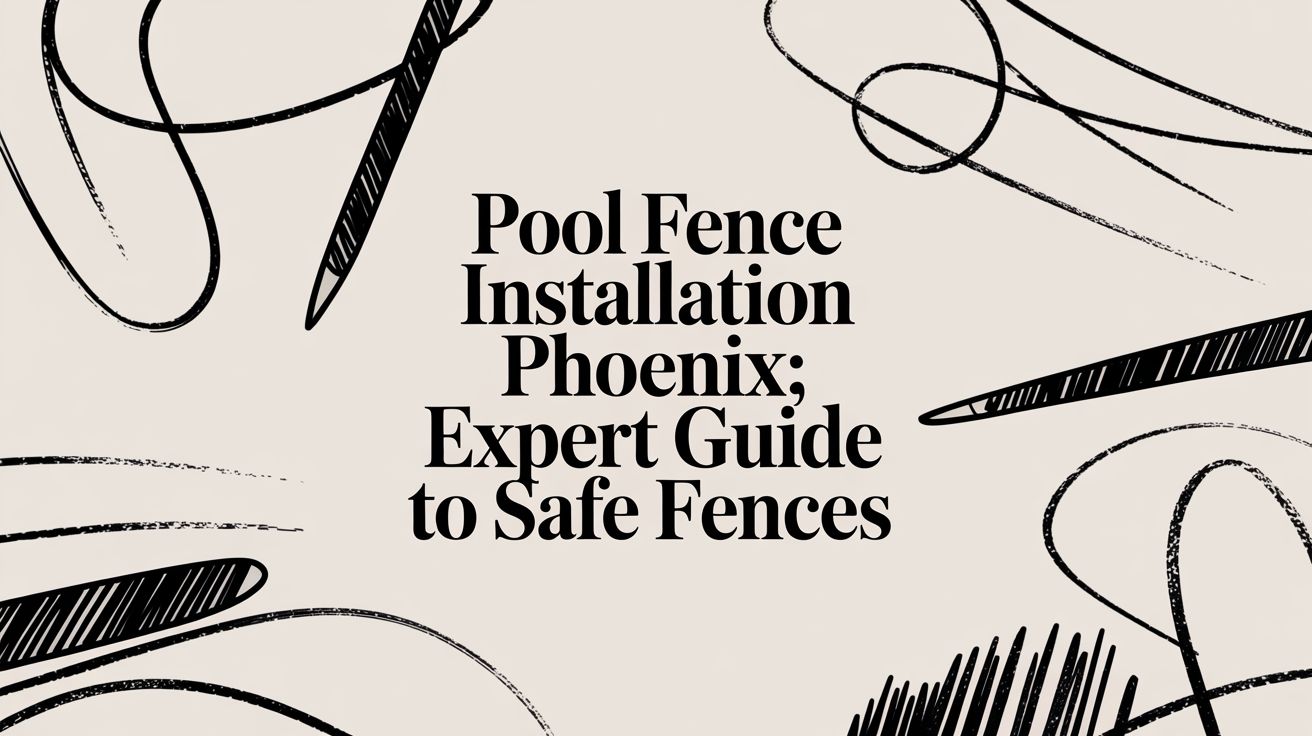
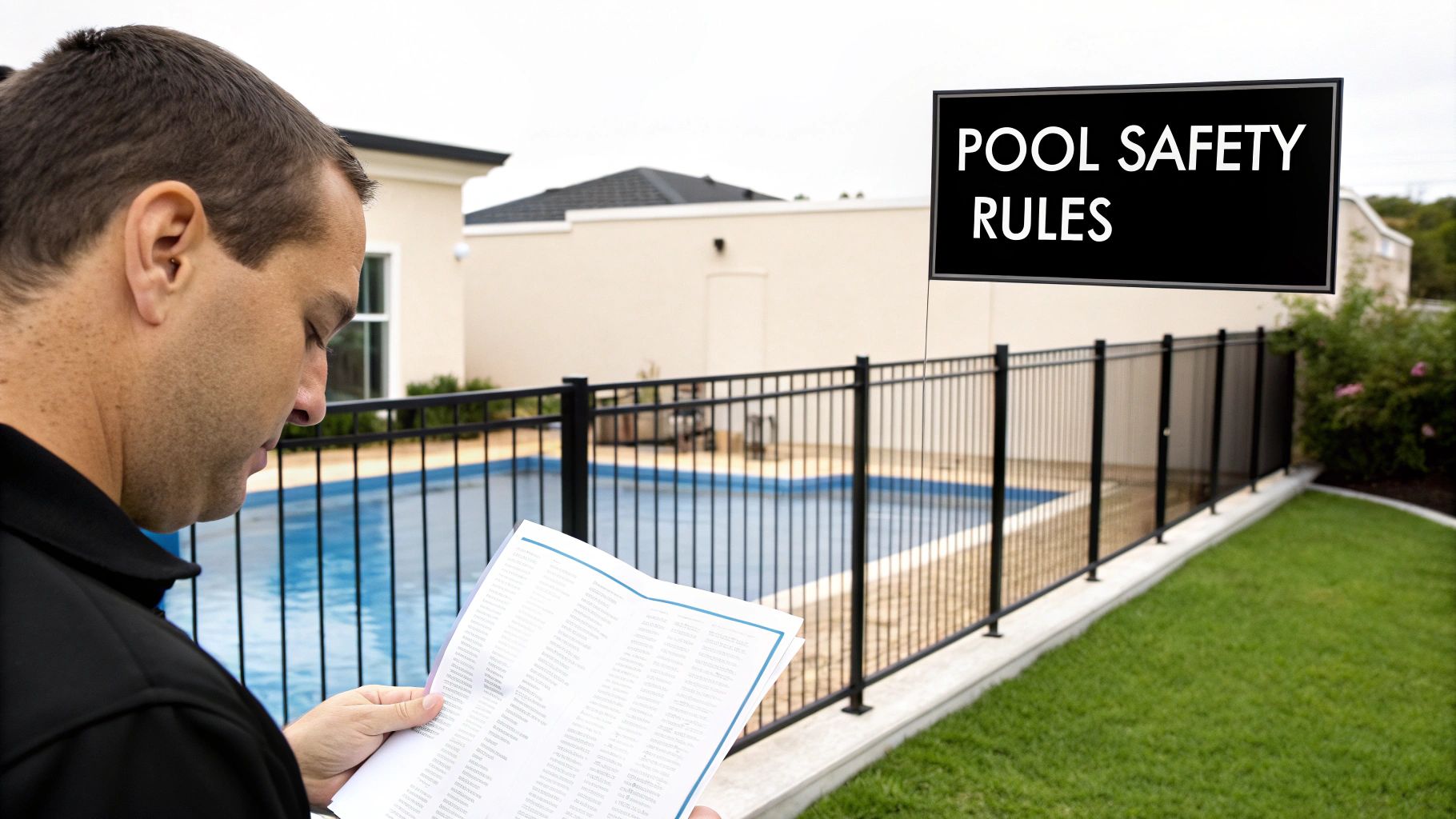
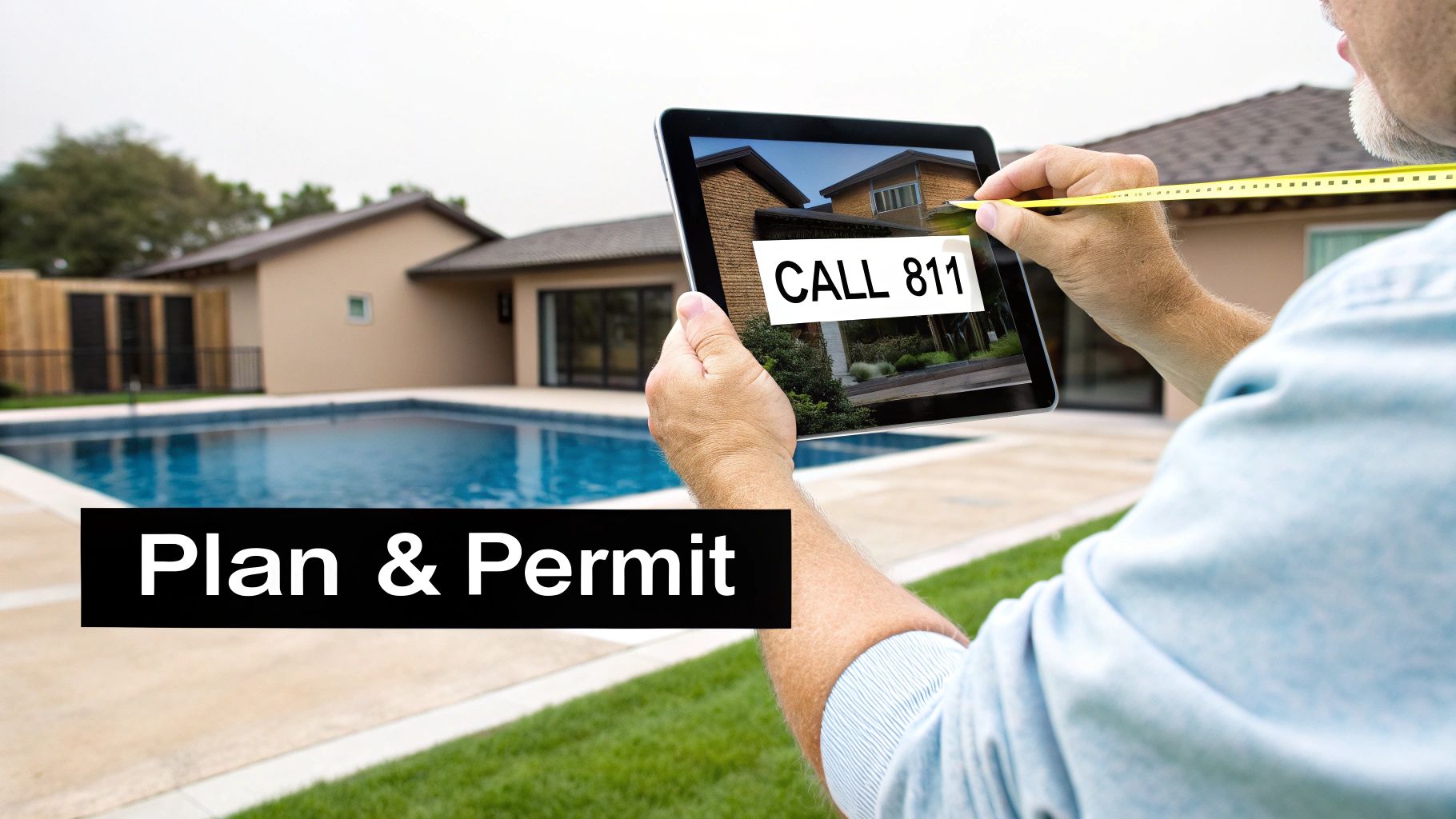
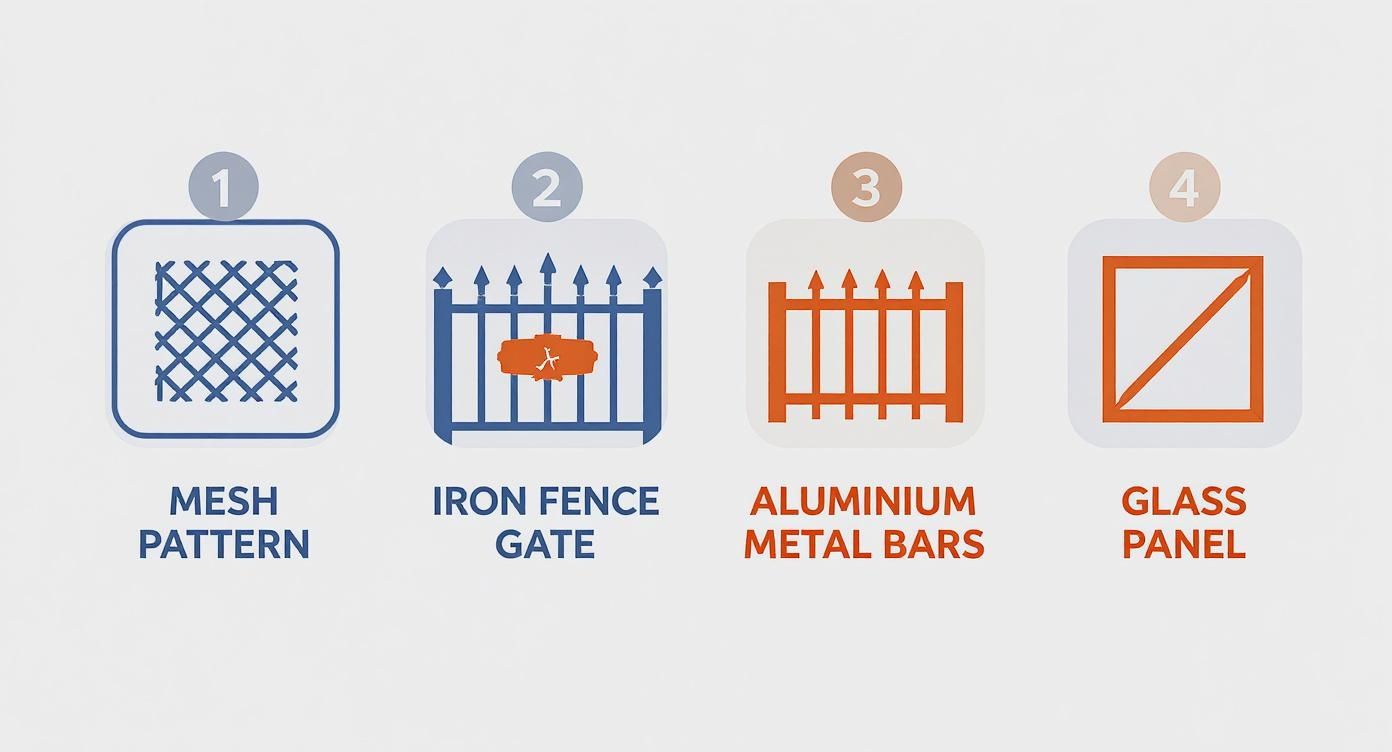

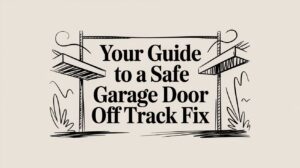


 (480) 548-0807
(480) 548-0807